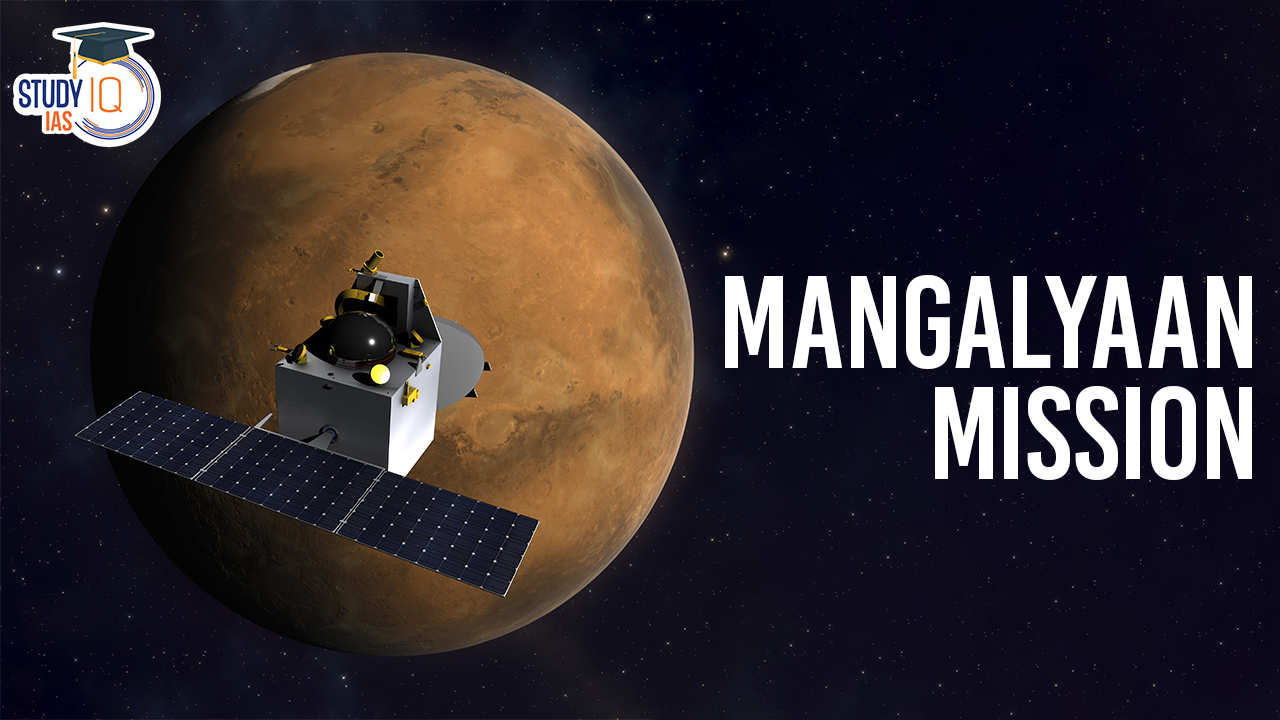Table of Contents
The Mars Orbiter Mission (MOM), also known as Mangalyaan Mission, was India’s first interplanetary mission. The Indian Space Research Organization (ISRO) launched the space probe on November 5, 2013. It entered Mars’ orbit on September 24, 2014, and ended in April 2022.
Mangalyaan Mission
The Mars Orbiter Mission (MOM), also known as Mangalyaan-1, was launched by the Indian Space Research Organization (ISRO) on November 5, 2013, marking India’s first venture into interplanetary exploration. Since September 24, 2014, MOM has orbited Mars, making India the first Asian nation to achieve this milestone on its maiden attempt. Launched via the reliable PSLV C-25 rocket, MOM is based on ISRO’s proven I-1-K satellite bus and carries 850 kg of fuel and five scientific payloads, including the Mars Color Camera. The mission, tracked by the Indian Deep Space Network and NASA-JPL’s Deep Space Network, showcases India’s space capabilities and aims to develop interplanetary mission technologies while studying Mars’ surface and atmosphere. Initially slated for six months, the mission was extended by 2-3 years in April 2015, completing over 8,000 orbits by December 2015.
| Attribute | Description |
| Name | Mars Orbiter Mission (MOM), commonly known as Mangalyaan-1 |
| Launch Date | November 5, 2013 |
| Space Agency | Indian Space Research Organization (ISRO) |
| Mars Orbit Entry Date | September 24, 2014 |
| Spacecraft Type | Indigenously-built space probe, India’s first interplanetary mission |
| Launch Vehicle | PSLV C-25 (XL version of the Polar Satellite Launch Vehicle) |
| Payload | – 850 kg of fuel – 5 science payloads, including Mars Color Camera (MCC) |
| Tracking | – Indian Deep Space Network (IDSN) near Bengaluru – Complemented by NASA-JPL’s Deep Space Network |
| Achievements | – ISRO’s entry into the elite group of space agencies reaching Mars – First Asian nation to reach Mars orbit – First successful Mars mission on its first attempt |
| Primary Objective | Develop technologies for interplanetary mission planning, design, management, and operations |
| Secondary Objective | Explore Martian surface features, mineralogy, morphology, and atmosphere using indigenous instruments |
| Mission Extension | Initially planned for 6 months, extended for an additional 2-3 years in April 2015 due to remaining fuel |
| Mars Orbits Completed | Over 8,000 orbits of Mars completed by December 2015 |
Objectives of Mangalyaan Mission
The primary mission objective was to showcase India’s capacity to conceive, strategize, and successfully execute a sophisticated interplanetary endeavor. Key objectives included:
- Inserting an orbiter into Mars’ orbit to investigate its surface characteristics, atmosphere, and mineral composition.
- Seeking evidence of past or existing life on Mars, with a focus on the presence of water.
- Evaluating the performance of vital technologies essential for future human missions to Mars, encompassing autonomous navigation, propulsion, and communication systems.
- Attaining global acclaim for India’s space program, fostering international cooperation in the realm of space exploration.
Mangalyaan Mission Launch Vehicle and LaunchPad
The Mars Orbiter Mission was carried into space using the Polar Satellite Launch Vehicle (PSLV) C-25, specifically an XL version of the PSLV. The launch took place at the Satish Dhawan Space Centre (SDSC) in Sriharikota, India, which is an operational facility of the Indian Space Research Organisation (ISRO). Located on Sriharikota Island, about 80 km north of Chennai, India, the SDSC boasts two launch pads: the First Launch Pad (FLP) and the Second Launch Pad (SLP). The successful launch of the Mangalyaan mission occurred on November 5, 2013, from the First Launch Pad at this facility.
Mangalyaan Mission Scientific Payloads
- Mars Color Camera (MCC): A versatile camera for mapping Mars’ morphological features and observing events like dust storms.
- Thermal Infrared Imaging Spectrometer (TIS): Measures Martian surface temperature, composition, and mineralogy.
- Methane Sensor for Mars (MSM): Detects and measures methane concentration in the Martian atmosphere.
- Mars Exospheric Neutral Composition Analyser (MENCA): Studies the Martian exosphere’s composition, density, and variations.
- Lyman Alpha Photometer (LAP): Measures Martian hydrogen and deuterium exospheric density.
Mangalyaan Mission Achievements
Key achievements of the Mangalyaan mission include:
- Showcasing Indian Space Technology: India’s successful mission to Mars marked its debut in interplanetary exploration, elevating its global reputation in the space domain.
- Mars Surface and Atmosphere Study: The spacecraft collected data on Mars’ surface features, mineralogy, atmospheric processes, and trace gases, contributing to a deeper understanding of the planet’s geological and climatological history.
- Surface Radiation Environment Study: Mangalyaan investigated the Martian surface’s radiation environment, shedding light on its impact on both the surface and atmosphere.
- Solar Wind-Mars Interaction: The mission examined the interaction between the solar wind and the Martian atmosphere, enriching our knowledge of the processes shaping the Martian environment.
- Data for Future Missions: Mangalyaan’s data will inform the design and planning of upcoming Mars missions, including unmanned and manned endeavors.
- Historical Mars Orbit Entry: India achieved Mars Orbit Insertion on its first attempt, becoming the first nation to do so. Remarkably, the mission cost just $74 million, less than the budget of the Hollywood movie “Gravity.”
- Budget Efficiency: The Mars Orbiter Mission stands as the world’s most cost-effective interplanetary mission, demonstrating India’s ability to achieve space exploration milestones efficiently.
Mangalyaan Mission Major Science Results
MOM made significant contributions, such as studying solar coronal dynamics during the post-maxima phase of solar cycle 24, observing enhanced Martian atmosphere escape during a global dust storm, and detecting ‘hot’ Argon in Mars’ exosphere. It also revealed the abundance of Oxygen surpassing Carbon-Dioxide at a specific altitude during perihelion evening hours.
Mangalyaan Mission Importance for India
The Mangalyaan mission holds significant importance for India for several compelling reasons:
- Technological Achievement: Mangalyaan represents a remarkable technological feat as India’s first interplanetary mission. It showcases India’s indigenous capabilities in spacecraft design, development, and space exploration.
- Global Recognition: The successful mission has elevated India’s status on the global stage. It demonstrated the country’s proficiency in space technology and solidified its position as a credible player in space exploration.
- Enhanced Scientific Research: Mangalyaan’s data collection on Mars’ surface, atmosphere, and radiation environment provides a treasure trove of information for Indian scientists and researchers. It enhances the country’s expertise in planetary science and exploration.
- Strengthened International Collaborations: The mission involved collaboration with scientists and engineers from around the world, fostering stronger ties in the field of space exploration. It has also led to joint research efforts and knowledge sharing.
- Inspiration for Future Generations: Mangalyaan’s success has captured the imagination of the Indian public, particularly the youth. It serves as a source of inspiration, encouraging the younger generation to pursue careers in science, technology, engineering, and mathematics (STEM).
- Economic Opportunities: Success in space exploration can lead to economic opportunities, including the potential for space commerce, satellite services, and collaboration with international space agencies.
- National Pride: Mangalyaan has become a source of national pride, symbolizing India’s ability to achieve ambitious goals. It unites the country in celebrating scientific achievements.
- Strategic and Defense Benefits: India’s expertise in space technology developed through missions like Mangalyaan can have strategic and defense implications, including enhanced communication, navigation, and surveillance capabilities.
- Scientific Advancement: The mission contributes to India’s scientific advancement by expanding its knowledge of the Martian environment, which can be applied to future missions and research endeavors.
| Aspect | Description |
| Mission Name | Mars Orbiter Mission (Mangalyaan) |
| Launch Date | November 5, 2013 |
| Space Agency | Indian Space Research Organization (ISRO) |
| Achievement | India’s first successful interplanetary mission, reaching Mars’ orbit |
| Scientific Goals | Study Mars’ surface, atmosphere, radiation, solar wind interaction |
| International Collaboration | Collaboration with scientists and engineers worldwide |
| Global Recognition | Elevated India’s standing in the field of space exploration |
| Technological Milestone | Demonstrated India’s space technology capabilities |
| Inspiration for Youth | Captured the imagination of the public, motivating STEM careers |
| Scientific Data Collection | Surface features, mineralogy, radiation, and atmosphere data |
| Economic Opportunities | Potential for space commerce and satellite services |
| National Pride | Source of pride and unity among the Indian population |
| Strategic and Defense Implications | Enhancing strategic and defense capabilities |
| Scientific Advancement | Contributed to India’s planetary science expertise |
Mangalyaan Mission UPSC
The Mars Orbiter Mission (MOM), also known as Mangalyaan, was India’s first interplanetary foray, launched by ISRO on November 5, 2013. It entered Mars’ orbit on September 24, 2014, and concluded in April 2022. This mission marked India’s prowess in space technology, bolstering its global standing. MOM’s primary objectives included investigating Mars’ surface, atmosphere, and water presence. It also aimed to test technologies essential for future Mars missions. The mission’s success garnered international recognition and fostered scientific research. It ignited the nation’s imagination, especially among youth, and held the potential for economic opportunities, strategic benefits, and scientific advancement.


 INS Udaygiri, Key Features, Capabilities...
INS Udaygiri, Key Features, Capabilities...
 Mental Healthcare in India, Scope and Go...
Mental Healthcare in India, Scope and Go...
 Most Commonly Used Cancer Drugs and Thei...
Most Commonly Used Cancer Drugs and Thei...





















